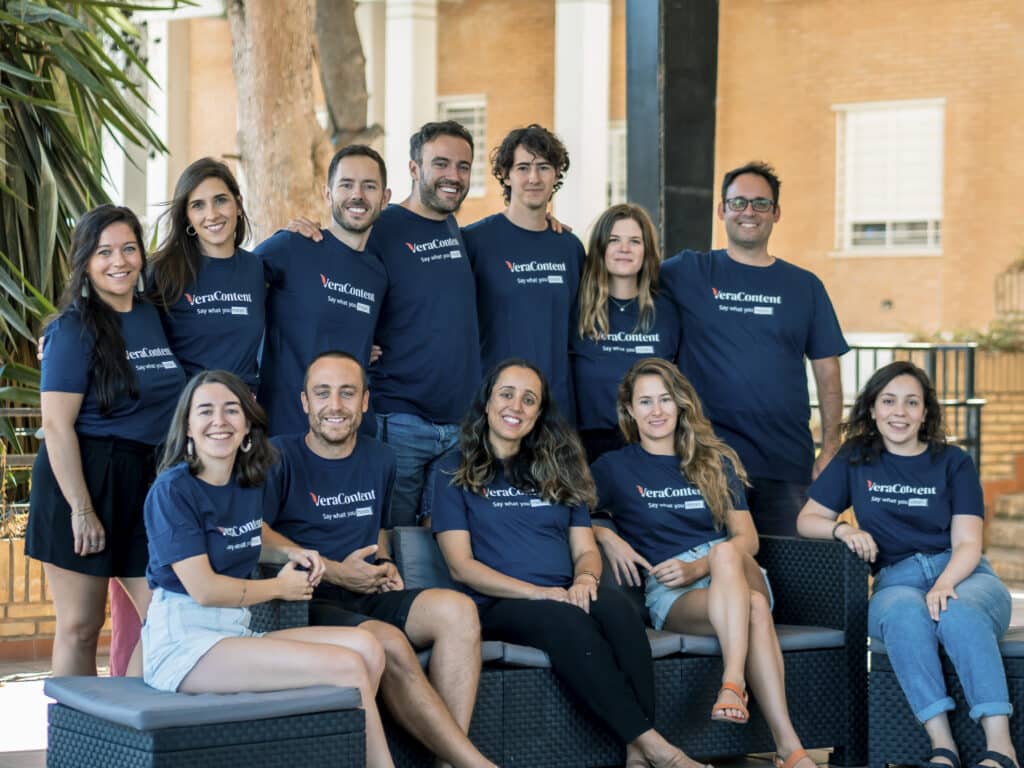Consistent multilingual content production is vital for reaching new markets and ranking well on search engines. It also gives you an edge over your competitors. After all, you don’t want them to break into new language markets before you do.
But how do you create multilingual content that aligns with your global content marketing strategy? Keep reading for a step-by-step guide to developing a content production process for multiple languages, including a breakdown of VeraContent’s five-step process.
Multilingual content production: an overview

Quality multilingual content creation starts with your normal content production process.
There are two major facets to consistently creating great content:
- Ensure each stage of production is clear and well-organized.
- Have a system of quality checks before your content is published.
Just two core concepts—simple enough, right? Let’s look at how this works in practice.
Content creation processes mimic many of the same steps as traditional newspaper editing processes, which includes:
- Finding a relevant topic for the newspaper
- Checking the content for accuracy
- Editing the copy for style, grammar, and tone
- Doing a final proof for layout, design and content
The traditional newspaper process is time-intensive, but print is also permanent. Online publishing is less so because, by nature, it’s easier to edit and update after posting.
Because of this, the online content production process is usually more streamlined. We’ll break down each stage more later on. But for now, let’s sum up our five-stage process at VeraContent:
- Our SEO expert and editors decide on relevant topics for our target markets.
- A project manager assigns the project to a writer, along with a brief and all necessary information.
- Our linguists and writers collaborate with project managers, asking questions and receiving feedback as they finish the content.
- Finished content goes through two rounds of edits.
- Content is published according to our editorial calendar.
Now, here’s where we get into creating a multilingual content production system. When you have a well-organized editorial process, you can adapt it across languages.
“If you have a good process for creating the content in the first place and have a standard way of making sure it’s of top quality, then it’s going to make you stand out.”
– Shaheen Samavati, CEO of VeraContent
Because VeraContent’s process is so optimized, we maintain consistent content production quality across all languages. However, we also know that different languages have nuances and considerations, so we make sure to adapt the process as needed. Typically, we create style guides and guidelines for each language and client.
Our guidelines and briefs give our writers a clear picture of what the client wants before they start writing. This might include details on the target language market, examples of the brand’s tone and voice, and direct information on deadlines and word counts.
See also: Best content marketing platforms and tools: A comprehensive list
Can you repurpose content for another language?
Should you be creating content from scratch or translating your existing content? Or a mix of both?
After all, repurposing your existing content is appealing as it saves time and resources. What’s not to like?
Effective multilingual content production takes more than putting your original content through an online translator. At times, it involves transcreating—when a linguist creatively transmits the message with a language’s nuance, idioms, and local expressions in mind. Other times, it requires a writer to provide new content from scratch for that specific language market.
Some content is easy to reuse. For example, product pages, general website copy, and even some social or blog content can be translated—so long as you remember to localize the blog’s SEO.
See also: What is international SEO and how to do it the right way
But not all content can or should be used for every language market. This is where we get into localization—that is, going beyond content translation and creating content that suits a market’s social norms, cultural values, nuances and laws.
“Creating irrelevant content with no strategy in mind, just to show your followers that you post regularly, is a Chronicle of a Death Foretold. Keep your content relevant to your target consumers, consistent, and according to your plan.”
– María Scheibengraf, Spanish translator and content writer
See also: Marketing content translation: 10 tips to going multilingual
This is especially true if you have products or services that need to change based on the market, such as region-based B2B content. As VeraContent’s CEO, Shaheen Samavati, says, “If your product offering has to change because of something in that market, then you’ll have to change your messaging around that.”
Pro-tip: Listen to our podcast episode for more on this topic: When to translate content vs. create it from scratch for new markets
If you’re struggling with where to start localizing your content, download our free worksheet for adapting your content strategy to local markets:

The five stages of multilingual content production

Let’s look deeper into our five stages of multilingual content production at VeraContent.
Step 1: Research your language markets
The first step is understanding your market audience’s desires and pain points.
What sort of content will connect with your audience? Does your target language market prefer punchy, emotions-based copy, such as American audiences? Or do they prefer descriptive, detailed copy like in Germany?
This is also the stage where you can assess what content you already have. As we said above, taking existing content and localizing it for a new language market is possible, but only after you decide if repurposing your existing content for a new market fits your multilingual blog strategy.
Step 2: Assign the project to a writer or linguist
You don’t need your team to be fluent in every language you publish in. Trusted external talent will take you far.
At this point in VeraContent’s process, a project manager assigns a project to a writer, along with a brief, style guide and any further necessary documentation.
Some companies prefer working with freelance writers because it allows you to hire locals from different language markets to work on specific projects as needed. Others choose to build a team of in-house employees who can devote their time to creating content for their assigned language.
Another route is going with a multilingual content agency that can pool their expert localization knowledge with local talent—taking the hassle of managing multiple people out of your hands. For example, if you’re an English-speaking company trying to break into Spanish-speaking markets and hiring a team of linguists and native editors isn’t within your means, you can hire an agency with experience in Spanish-language markets.
“Getting the right writers and an editorial process in place from the beginning of your content production process is worthwhile because if you don’t, it could cost you more in the long run. For example, if you make mistakes and publish things that aren’t true or in line with your brand, you may suffer those consequences later on.”
Shaheen Samavati, CEO of VeraContent
See also: Choosing the right transcreation agency for your business
Step 3: As the project is in development, make use of workflow tools, checklists and an editorial calendar
At VeraContent, we love digital tools and checklists to help monitor projects and encourage collaboration. Some workflow tools we use include ClickUp, Pipefy, Notion and Monday.com. Basing our process around these tools encourages organization and communication between linguists, clients and our team.
See also: 8 best tools for running an effective multilingual blog
An editorial calendar is absolutely necessary for multilingual content creation, as it can quickly get complicated. A multilingual blog calendar should keep track of dates, including all parts of the multilingual content production and editorial process—proofreading, fact-checking, editing and rewrites, social media updates, and publishing. We recommend using a workflow app like Trello.
Pro tip: Read our article on how to make a blog editorial calendar in multiple languages
With workflow tools and a calendar, you and your team will be clear on how and when something needs to be done.
This stage can happen simultaneously with stage two and four, as it’s essentially about monitoring progress. For us, this is when we’re communicating with our writers and editors by answering their questions and providing feedback.
Step 4: The editorial stage
Arguably, this stage is the most important part of any multilingual content production process.
At VeraContent, our golden rule is to have two rounds of editing:
- The first edit checks for accuracy and to ensure the content follows the brief.
- The second edit checks for tone, grammar, style, etc.
As Shaheen Samavati puts it, “Those two steps are essential and anything above that is the gravy.”
Usually, but not always, we assign two different editors for the two steps. We do this so that our content is edited with a wider perspective. However, one editor can complete both rounds, so long as they can look at the content with fresh eyes each time.
Step 5: Publish and evaluate
After editing, your content is finally ready to be published according to your calendar.
Now it comes time to evaluate. When your content, whether it’s an article, blog post, webinar, product page, or something else, has been online for a while, check on your content’s performance.
Assess these main questions:
- Is the content ranking highly on search engines? Is it performing better or worse than your existing content?
- In your content that performs well, what keywords do they use?
- What content is driving the most clicks and conversions?
- Did it resonate with your audience? Is it getting comments, shares, etc.?
- For content only getting clicks, but no conversions, how can that content be optimized?
Your answers will tie back into the first stage (research) because this process is ideally a continuous loop. If the content isn’t ranking high on Google or the click-through-rate (CTR) isn’t high compared to the original content, perhaps take a look at your multilingual SEO practices. It could be a case of technical SEO issues, like improperly implemented hreflang tags.
See also: 5 best practices to improve your multilingual website SEO
Or it could be a deeper issue of the content not connecting with your target language market. Either way, evaluating your content will give you insights and help you guarantee your next post performs better.
Fine-tuning your multilingual content production workflow

You’ve researched and created multilingual content, edited, published and evaluated its performance. But while each stage of the process might seem easy on paper, real life is never so simple. Let’s look at a few ways to fix any snags in your multilingual content workflow.
Firstly, identify where the problems are.
For example, was the writer unable to complete the content by the deadline? Did the content initially not follow the brief or have to go through multiple rewrites? These instances could indicate that the brief or editorial feedback wasn’t clear enough for your writer. Go back to the drawing board, and assess how well your documentation explains the client’s goals and style.
Typically, the root issue comes down to a company being unable or not used to creating and editing content. If you don’t have the resources for a well-organized production process, trying to make it work for other languages is a non-starter.
“It’s a big operation to consistently create content and design all the steps around it. And if you’re a company that, for example, designs widgets, you’re used to a completely different process.”
– Shaheen Samavati, CEO of VeraContent
We can’t emphasize it enough: briefs, guidelines and style guides are crucial to the success of your multilingual content. The more clear information your writer or linguist has, the fewer revisions and rewrites the process will require—saving you time and money.
This tip ties into our golden rule for content production in general: Promote trust and collaboration with your writers and linguists. At VeraContent, we’ve built our process to include many opportunities for writers to ask questions and receive feedback from our editors and project managers.
“Our feedback system allows collaboration to go really well, but it also allows us to build trust with everyone we’re working with.”
– Kyler Canastra, head of business development at VeraContent
While our clients and writers might work in other languages, we keep the production process in English, so our project managers can monitor progress and pitch in during the editorial process.
Download our checklist on hiring, onboarding and nurturing relationships with freelancers:

Let’s get started
At VeraContent, we’ve spent years honing our own multilingual content production process and creating a network of trusted professionals based in markets around the world. We’re experts at creating multilingual content for global companies moving into new markets, such as Spotahome and Current Foods.
If you’re excited about breaking into multilingual content marketing and want help creating or fine-tuning your multilingual content production process, reach out to us today to find out if you qualify for a free content consultation.

